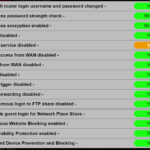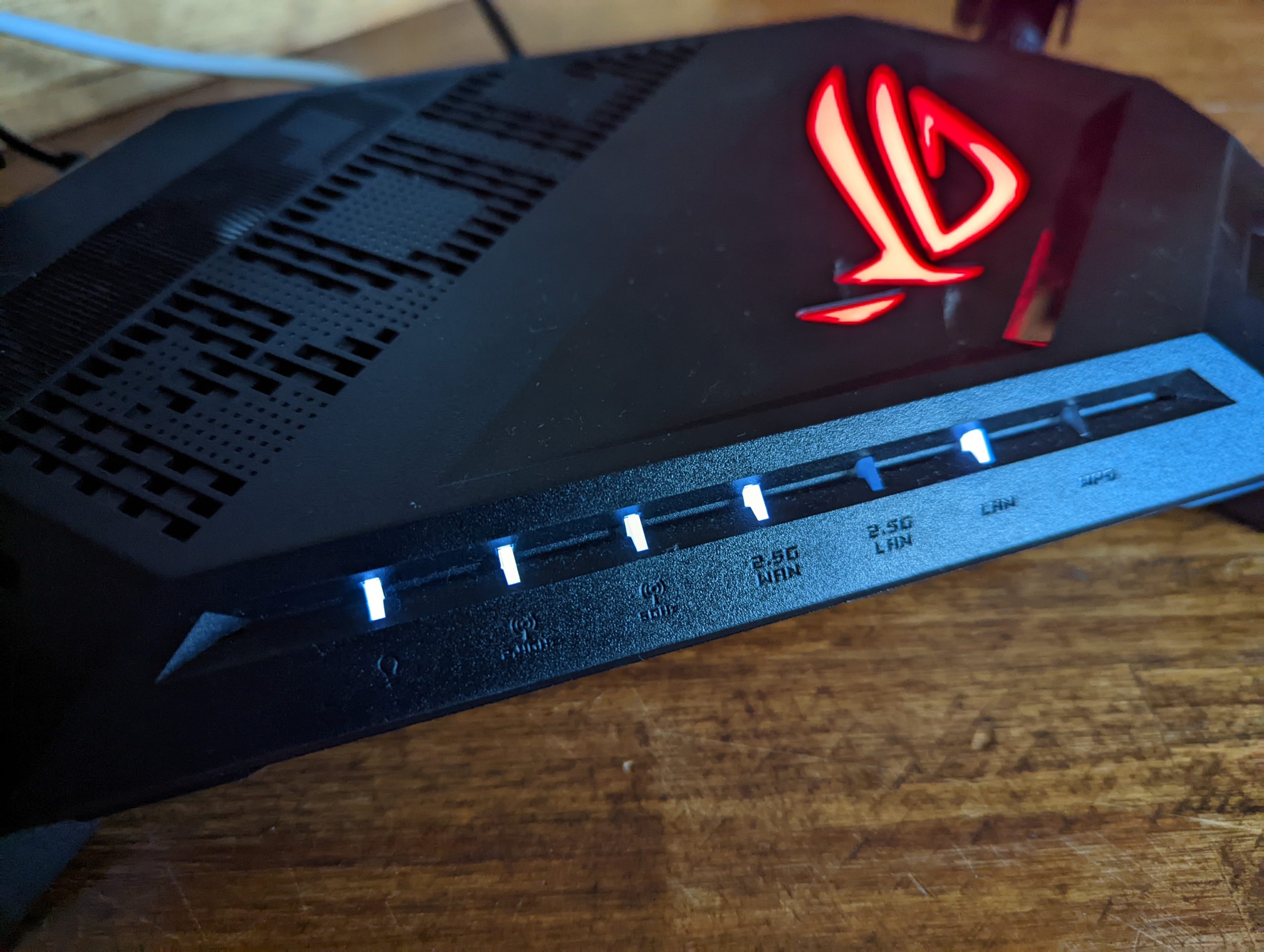A good router is at the heart of every network, in the case of high level enterprise setups; potentially several of them. But for home use, that’s overkill… We’ve looked at a number of low, mid and high end routers at Ausdroid over the last couple of years. Today we’re taking a look at the Asus GT-AX6000, a top flight, Wi-Fi 6 router with all the trimmings.
In the past, I’ve had the pleasure of enjoying Republic of Gamers equipment and when the GT-AX6000 was sent over to use for testing, I had high expectations. There is so much to explore on the router, much of which is standard features so we’ll gloss over them, but the more specific gaming and Asus specific features; we’ll delve into.
The package contents
The GT-AX6000 router arrived with another review unit (coming soon…) and the shipping box was enormous, but that’s because in comparison to the router I was running this device is huge. But apart from the aesthetics, there are several good reasons for that. The router is well protected during shipping in a tray surrounded by cardboard packaging with soft plastics protecting the router, power brick and, dominantly recyclable materials.
The router isn’t your typical NBN style router with a single WAN port and four network ports. It’s got four gigabit LAN ports plus two, 2.5Gb LAN ports that can also operate as WAN ports, both of which can operate as 1Gb WAN and aggregate connections.
On top of this, there are two USB ports for connecting devices and drives that can cover a number of needs such as Internet file sharing, Samba shares, FTP, printer sharing, a download manager or even a USB 4G stick for network failover. The four, yes four, external antennas look a bit out there but do serve a purpose when it comes to delivering Wi-Fi performance across the dual-band offering at consistent speeds.
Setup: Quick, easy and impressive
A few years ago, I upgraded my home network from an Adhoc mess of cables to a planned and structured network. This was to reduce reliance on — increasingly congested — Wi-Fi for devices capable of ethernet connection and to improve the overall performance.
One of the requirements, when I designed the network, was to ensure I could easily change routers, which came into play here. The WAN cable came out of the old router, as did the network switch feed and into the new. Add power and it was time to set up my NBN connection.
When I loaded the setup page — https://router.asus.com a universal to Asus, easy to remember way to access y our router — on my PC, I was impressed to see that once I put my NBN connection details in, the router had detected the IP range I previously used and already assigned it, as well as my statically assigned IPs.
Other features: Routing and protection
As already mentioned, there are a lot of features on this router and some are standard features so we’ll gloss over the run of the mill stuff like parental controls, IPv6 settings and firewall options. But we will take a bit of a closer look at options like AI Protection, the VPN setup, Traffic Analyzer and network mapping.
Let’s start with AI protection which has been created in partnership with Trend Micro to protect your router and everything behind it from malicious attacks. It starts by making some suggestions on ways to improve the security of your network such as turning off disused features and potential attack vectors such as web access to your router. Once enabled, other features such as malicious site blocking, setup of intrusion prevention and preventing infected devices from becoming part of a botnet are enabled.
There are a couple of very good options in the VPN stakes here, the first being to access your home network via a VPN. Of course, this is the right way to do this, not leaving ports open that can be scanned and attacked. Impressively though, this also comes with the option to use a VPN provider and ensure that all of your traffic is routed through that VPN — without configuring each device — for your entire network. Hiding your online activities from your ISP and the government, potentially also opens extra options for entertainment through companies like Netflix.
Parental controls are another feature that’s come to be expected in home routers these days, but many routers have it as a paid option. Asus, however, provide the protection for free as part of the offering which is a nice little bonus, particularly with the granular controls available.
Performance: Coverage and consistency
For the vast majority of users, typically the bottleneck in accessing the Internet is the speeds available on NBN. With most routers capable of handling a Gigabit NBN connection it’s actually quite difficult to push routers to their limits. What is evident from our testing time with the GT-AX6000 is just how much of a difference a high quality Wi-Fi 6 — an important upgrade — router with plenty of processing power makes.
For Aussies, this is a router that will top out your NBN connection before your router begins to struggle. The theoretical top speeds at 5Ghz and 2.4Ghz are 4,084Mbps and 1,184Mbps respectively, but if you’re transferring data internally that’s only half the story.
From an outright speed perspective: I was able to consistently top out my 100/40 NBN connection on either wireless or wired connections.
I already mentioned the 2.5Gbps ports which are hugely useful if you’re running a NAS — that also has 2.5Gbps — on your internal network. This will allow multiple, high speed internal connections to your NAS which will make internal data transfer far more time efficient. Perhaps an upgrade that content creators and streamers may wish to look into, longer term having network-based storage could improve general performance and reduce upgrade costs.
First and foremost, this is a gaming router and this shows that the first ethernet port is prioritised for gaming. If you’ve got a gaming PC or console, this is the port to plug it into. Traffic to this port is prioritised, ensuring the best possible gaming experience. There is also a feature in the router software called Game Boost which recognises and prioritises game data, which helps to minimise — I didn’t see a single one in testing — any potential for lag spikes.
Regardless of what my family and I threw at it, the GT-AX6000 met the reasonably significant needs of my home network including over 60 devices, 11 smart speakers, phones, tablets, laptops and IoT devices. This equates to downloads, plenty of streaming, gaming and outbound connections across a lot of the connected devices.
Is there any downside?
The price is without a doubt the biggest detractor for a lot of people. With plenty of options that provide Wi-Fi 6 at a significantly lower cost, there are many users who simply won’t look at this top end of the routing shelf. So the cost alone is creating a barrier to entry.
The other detractors are very much subjective since everyone’s preferences on aesthetics is different. I don’t mind the “out there” look that ROG devices typically bring, they have a distinct feel about them but it’s clearly not for everyone. As part of this, and the necessity with the raw power of the router is the physical size, being roughly twice the footprint of a basic home router.
So is $799.00 a fair price?
There’s a lot to consider here because there are absolutely users who have networks that will benefit from a router at this level. The simple answer is, for most people there isn’t the value in spending this much on a router.
It’s not cheap, so think about whether you’re going to get value from it and it’s definitely not a subtle device in presentation. You get a very impressive device from a performance perspective with really good wired connection options and not just quick, but consistently quick wireless connection.
There are simple and largely automated ways to get a great experience for gaming with the additional peace of mind of network security and, parental controls — free inclusion — for those who want to use them. The final decision really boils down to whether or not you’ll see a difference with the GT-AX6000 and whether that difference will be worth $799.00
For my use case, during testing, I’ve seen increased network performance and a huge increase in Wi-Fi stability. But because of the design of my network, delivering gigabit wired connection where it’s needed, I haven’t seen huge increases in online gaming performance. I’d still say that the improvements make it worth considering, but it is difficult to recommend to others at the price.
If you need a router with truly impressive performance and customisation that doesn’t require network engineering knowledge this is an outstanding option. Gamers will see increases in performance, particularly if the primary connection is wireless, and this will increase your internal network performance.
Disclosure Statement
Asus have allowed Ausdroid to retain the product for long term evaluation













no wifi 6e
too expensive